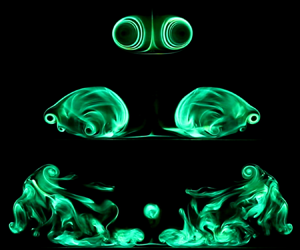Article contents
Collision of vortex rings upon V-walls
Published online by Cambridge University Press: 14 July 2020
Abstract

A study on  ${Re} =2000$ and 4000 vortex rings colliding with V-walls with included angles of
${Re} =2000$ and 4000 vortex rings colliding with V-walls with included angles of  $\theta =30^{\circ }$ to 120
$\theta =30^{\circ }$ to 120 $^{\circ }$ has been conducted. Along the valley plane, higher Reynolds numbers and/or included angles of
$^{\circ }$ has been conducted. Along the valley plane, higher Reynolds numbers and/or included angles of  $\theta \leqslant 60^{\circ }$ lead to secondary/tertiary vortex-ring cores leapfrogging past the primary vortex-ring cores. The boundary layers upstream of the latter separate and the secondary/tertiary vortex-ring cores pair up with these wall-separated vortices to form small daisy-chained vortex dipoles. Along the orthogonal plane, primary vortex-ring cores grow bulbous and incoherent after collisions, especially as the included angle reduces. Secondary and tertiary vortex-ring core formations along this plane also lag those along the valley plane, indicating that they form by propagating from the wall surfaces to the orthogonal plane as the primary vortex ring gradually comes into contact with the entire V-wall. Circulation results show significant variations between the valley and orthogonal plane, and reinforce the notion that the collision behaviour for
$\theta \leqslant 60^{\circ }$ lead to secondary/tertiary vortex-ring cores leapfrogging past the primary vortex-ring cores. The boundary layers upstream of the latter separate and the secondary/tertiary vortex-ring cores pair up with these wall-separated vortices to form small daisy-chained vortex dipoles. Along the orthogonal plane, primary vortex-ring cores grow bulbous and incoherent after collisions, especially as the included angle reduces. Secondary and tertiary vortex-ring core formations along this plane also lag those along the valley plane, indicating that they form by propagating from the wall surfaces to the orthogonal plane as the primary vortex ring gradually comes into contact with the entire V-wall. Circulation results show significant variations between the valley and orthogonal plane, and reinforce the notion that the collision behaviour for  $\theta \leqslant 60^{\circ }$ is distinctively different from those at larger included angles. Vortex-core trajectories are compared to those for inclined-wall collisions, and secondary vortex-ring cores are found to initiate earlier for the V-walls, postulated to be a result of the opposing circumferential flows caused by the simultaneous collisions of both primary vortex-ring cores with the V-wall surfaces. These circumferential flows produce a bi-helical flow mode (Lim, Exp. Fluids, vol. 7, issue 7, 1989, pp. 453–463) that sees higher vortex compression levels along the orthogonal plane, which limit vortex stretching along the wall surfaces and produce secondary vortex rings earlier. Lastly, vortex structures and behaviour of the present collisions are compared to those associated with flat/inclined walls and round-cylinder-based collisions for a more systematic understanding of their differences.
$\theta \leqslant 60^{\circ }$ is distinctively different from those at larger included angles. Vortex-core trajectories are compared to those for inclined-wall collisions, and secondary vortex-ring cores are found to initiate earlier for the V-walls, postulated to be a result of the opposing circumferential flows caused by the simultaneous collisions of both primary vortex-ring cores with the V-wall surfaces. These circumferential flows produce a bi-helical flow mode (Lim, Exp. Fluids, vol. 7, issue 7, 1989, pp. 453–463) that sees higher vortex compression levels along the orthogonal plane, which limit vortex stretching along the wall surfaces and produce secondary vortex rings earlier. Lastly, vortex structures and behaviour of the present collisions are compared to those associated with flat/inclined walls and round-cylinder-based collisions for a more systematic understanding of their differences.
- Type
- JFM Papers
- Information
- Copyright
- © The Author(s), 2020. Published by Cambridge University Press
References
REFERENCES
- 18
- Cited by


